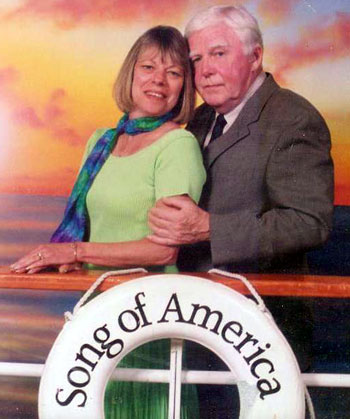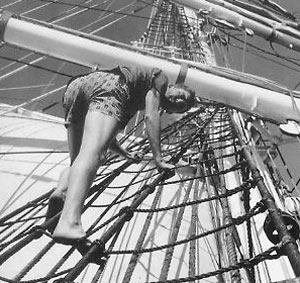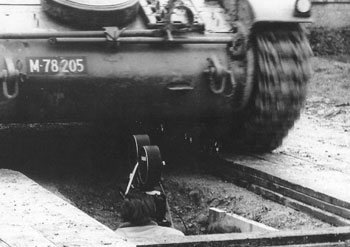Robert Gaffney, cinematographer
|
Read more
at in70mm.com The 70mm Newsletter |
| Written by: Sherry Gaffney | Date: 24 September 2006 |
 Sherry and Robert Gaffney
(2006) Sherry and Robert Gaffney
(2006)Bob Gaffney was born on October 8, 1931 in The Bronx, NY. He has been in the film business for over 55 years. He left Iona College at the end of his sophomore year to work with Louis de Rochemont, creator of “The March of Time”, as an office boy, film editor, producer, and ultimately as a Director/Cameraman. While with De Rochmont, Bob worked on “Cinerama Holiday” and designed, built and operated the camera for Cinemiracle’s film "Windjammer". He is the only cameraman we know of who was run over by a submarine while filming it. Bob then started his own company, Seneca Productions, where he concentrated on documentaries many of which were shot in 70mm; a format that he really loves. Three of these short films were nominated for Academy Awards for best cinematography: "Sky over Holland", “Fortress of Peace”, and “Rooftops of New York”. He also co-wrote, directed and shot the now cult film “Frankenstein Meets the Space Monster.” While still at Seneca Bob travelled with Stanley Kubrick filming all the second unit footage for “Lolita” and later filmed the end sequence of “2001:A Space Odyssey” at Monument Valley, Utah. In 1968 Kubrick asked Bob to come to England to produce his next picture “Napoleon.” Bob spent over two years in pre-production on this film budgeting, scouting locations, negotiating, and working out of the MGM studio in England. Unfortunately the picture was never produced. Upon his return to the United States in 1970 Bob started directing and shooting television commercials for major advertising agencies. He opened his own production company, Bob Gaffney Productions, where he did hundreds of commercials for such clients as Miller Beer, Dannon Yogurt, Eastern Airlines, Gulf Oil, Honda, The Golden Nugget Hotel and Casino, Ford and Sony. Production of these commercials took him all over the world from many countries in Europe, to the Sahara Desert, to New Zealand to Russia. He directed celebrities such as Telly Sevalas, Bing Crosby, Frank Sinatra and Orson Wells. The Miller Beer “Christmas Card” shot in 1974, a member of the Commercial Hall of Fame, is still running on the air every Christmas. Bob is now retired and lives in Brewster, N.Y. He recently spoke at Manhattanville College for an intersession course, on Kubrick and Wells. He is a member of the Directors Guild of America and the International Cameraman’s Guild. Bob Gaffeney's Awards Gold Lion - Venice Film Festival Palm d’Or - Cannes Film Festival Clio Award - Dannon Yogurt- “Russian Old People” Advertising Club of New York - multiple ANNY Awards Art Directors Club - multiple ANDY Awards Commercial Hall of Fame |
Further
in 70mm reading: Robert Gaffney Gallery The Passing of Bob Gaffney, 1931 - 2009 Working for Louis de Rochemont by Borden Mace "Windjammer" "The March of Todd-AO" "2001" "Motion" "Sky over Holland" Jan Jacobsen Louis de Rochemont Louis de Rocemont III Internet link: “Rooftops of New York” |
Windjammer Experiences as told by Bob Gaffney 9/20/06 |
|
 On
the first take of the underwater footage the camera was bolted to the diving
plane fin on the front of the submarine. When they opened the submarine
doors, jeans, mops, sponges and other debris came out and into full view of
the camera. We surfaced to develop a new plan. On
the first take of the underwater footage the camera was bolted to the diving
plane fin on the front of the submarine. When they opened the submarine
doors, jeans, mops, sponges and other debris came out and into full view of
the camera. We surfaced to develop a new plan.The submarine and the camera ship would come towards each other. The camera would be lowered to a depth of 80 feet and the submarine would be at 100 feet and fire its torpedo under the camera. They lowered the camera with me hanging on to it and I discovered myself at 100 feet, in the direct path of the torpedo. A navy diver surfaced to tell them to pull the camera up 20 feet but it was too late. I heard terrible whirring noises and when I looked behind me there was the submarine. It hit me and spun me in circles; luckily away from it and I swam as quickly as I could. The camera caught me doing my fastest swim ever. Again it was time to surface and make a new plan. |
“That
submarine scene emerging from the ocean waters is the single most impressive
shot I have ever seen on a motion picture screen.” Sir David Lean |
 As
they were raising the camera I noticed that it was bleeding air around the
entire circumference of the O-ring sealing the camera housing. I sat on the
camera as it was raised and opened the gate valves. The yard freighter that
was pulling us up caught a wave and knocked the camera and me into the side
of the ship. All three magazines broke off. Time for another conference. As
they were raising the camera I noticed that it was bleeding air around the
entire circumference of the O-ring sealing the camera housing. I sat on the
camera as it was raised and opened the gate valves. The yard freighter that
was pulling us up caught a wave and knocked the camera and me into the side
of the ship. All three magazines broke off. Time for another conference.I was on deck reloading and putting new castings on the camera when I looked out towards the horizon and saw the submarine that launched the torpedo getting ready to go again. The Captain of the submarine didn’t remember that all the front and aft torpedo tubes were loaded with water. The submarine got ready to dive and immediately sank with its nose in the air at a 90-degree angle. The sub Captain discharged water from the aft tubes and the submarine righted itself. |
|
 On
the next take all went well. The submarine fired the torpedo. Everyone was
at the proper depth and we got the shot. I had been at depth and up so many
times that I had to be re-lowered to depth to decompress and avoid getting
“The Bends” (too much nitrogen in the blood.) It took about an hour to get
me out of the water and it probably should have been slower as for years I
had itchy joints also known as “Diver’s Itch.” On
the next take all went well. The submarine fired the torpedo. Everyone was
at the proper depth and we got the shot. I had been at depth and up so many
times that I had to be re-lowered to depth to decompress and avoid getting
“The Bends” (too much nitrogen in the blood.) It took about an hour to get
me out of the water and it probably should have been slower as for years I
had itchy joints also known as “Diver’s Itch.”By the way, none of the footage was used in the film. An aside: One of the Navy Divers assigned to me saw the submarine coming at us and immediately took off his watch and put it in his bathing suit pocket so he could put in a claim for a new watch. |
|
Thought you might like a few fun stories.... |
|
 Robert
Gaffney in hole in front of a tank. Filming of "Fortress of Peace" Robert
Gaffney in hole in front of a tank. Filming of "Fortress of Peace"During one of the flight sequences in "Sky Over Holland" the pilot pulled too many G's and became quite sick. Bob landed the fighter jet and no he does not have a pilot's license. Also during "Sky" the ice skating sequence where the people are in single file skating from right to left; the Producer was yelling at Bob to turn off the camera as he was wasting film once the people came through the frame...Bob kept rolling and another group came through.....this is probably Bob's favourite shot in the film. Again during "Sky"- the glass blowing sequence. As the camera moves in closer and closer to the blue bottle being made you can see Bob's reflection (behind the camera) in the bottle. You have to look closely. During "Fortress" one of the tanks going over Bob's head was slightly misaligned and knocked the magazines off the camera. Bob was very lucky that day! Back to "Sky" - Bob says the most difficult shot in the film is in the VanGogh sequence. The camera was hand held through the roof of a VW as the car moved quickly down the road through the autumn leaves. |
|
 Also in "Sky" - the fishermen in the little boats were not waving at
Bob as he came very close to them in a helicopter. They were waving him away
as he was scaring the fish. The same is true of the Shot on the Rhone, done
from a jet...they were only 20 feet or so above the boats. Also in "Sky" - the fishermen in the little boats were not waving at
Bob as he came very close to them in a helicopter. They were waving him away
as he was scaring the fish. The same is true of the Shot on the Rhone, done
from a jet...they were only 20 feet or so above the boats.Bob loved making "Sky Over Holland". He travelled and lived in Holland for 1 year during the filming. He considers it one of his greatest achievements and a personal legacy to film lovers everywhere. |
|
|
Go: back
- top - back issues
- news index Updated 22-01-25 |
|
